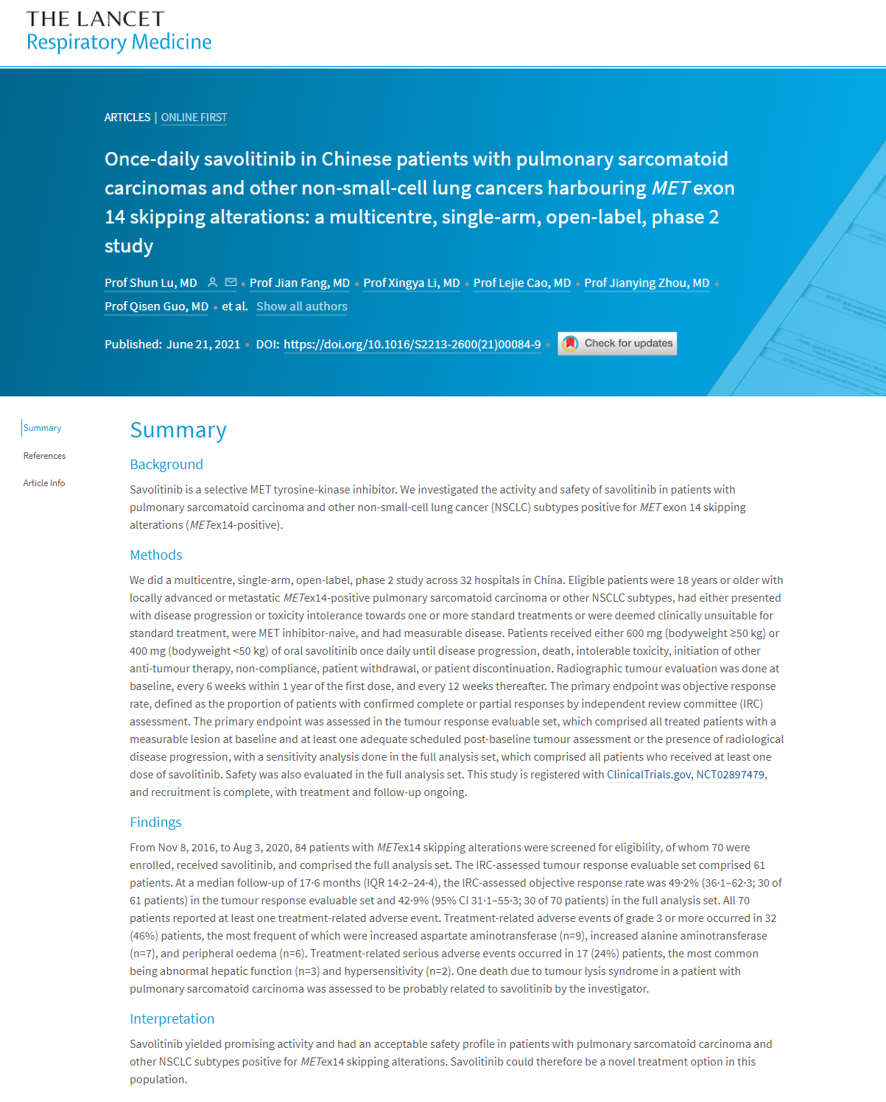《刺針 · 呼吸醫學》:賽沃替尼治療MET外顯子14 跳躍突變的中國非小細胞肺癌患者
Once-daily savolitinib in Chinese patients with pulmonary sarcomatoid carcinomas and other non-small-cell lung cancers harbouring MET exon 14 skipping alterations: a multicentre, single-arm, open-label, phase 2 study

Shun Lu, Jian Fang, Xingya Li, Lejie Cao, Jianying Zhou, Qisen Guo, Zongan Liang, Ying Cheng, Liyan Jiang, Nong Yang, Zhigang Han, Jianhua Shi, Yuan Chen, Hua Xu, Helong Zhang, Gongyan Chen, Rui Ma, Sanyuan Sun, Yun Fan, Jing Li, Xian Luo, Linfang Wang, Yongxin Ren, Weiguo Su
Summary
Background
Savolitinib is a selective MET tyrosine-kinase inhibitor. We investigated the activity and safety of savolitinib in patients with pulmonary sarcomatoid carcinoma and other non-small-cell lung cancer (NSCLC) subtypes positive for MET exon 14 skipping alterations (METex14-positive).
Methods
We did a multicentre, single-arm, open-label, phase 2 study across 32 hospitals in China. Eligible patients were 18 years or older with locally advanced or metastatic METex14-positive pulmonary sarcomatoid carcinoma or other NSCLC subtypes, had either presented with disease progression or toxicity intolerance towards one or more standard treatments or were deemed clinically unsuitable for standard treatment, were MET inhibitor-naive, and had measurable disease. Patients received either 600 mg (bodyweight ≥50 kg) or 400 mg (bodyweight <50 kg) of oral savolitinib once daily until disease progression, death, intolerable toxicity, initiation of other anti-tumour therapy, non-compliance, patient withdrawal, or patient discontinuation. Radiographic tumour evaluation was done at baseline, every 6 weeks within 1 year of the first dose, and every 12 weeks thereafter. The primary endpoint was objective response rate, defined as the proportion of patients with confirmed complete or partial responses by independent review committee (IRC) assessment. The primary endpoint was assessed in the tumour response evaluable set, which comprised all treated patients with a measurable lesion at baseline and at least one adequate scheduled post-baseline tumour assessment or the presence of radiological disease progression, with a sensitivity analysis done in the full analysis set, which comprised all patients who received at least one dose of savolitinib. Safety was also evaluated in the full analysis set. This study is registered with ClinicalTrials.gov, NCT02897479, and recruitment is complete, with treatment and follow-up ongoing.
Findings
From Nov 8, 2016, to Aug 3, 2020, 84 patients with METex14 skipping alterations were screened for eligibility, of whom 70 were enrolled, received savolitinib, and comprised the full analysis set. The IRC-assessed tumour response evaluable set comprised 61 patients. At a median follow-up of 17·6 months (IQR 14·2–24·4), the IRC-assessed objective response rate was 49·2% (36·1–62·3; 30 of 61 patients) in the tumour response evaluable set and 42·9% (95% CI 31·1–55·3; 30 of 70 patients) in the full analysis set. All 70 patients reported at least one treatment-related adverse event. Treatment-related adverse events of grade 3 or more occurred in 32 (46%) patients, the most frequent of which were increased aspartate aminotransferase (n=9), increased alanine aminotransferase (n=7), and peripheral oedema (n=6). Treatment-related serious adverse events occurred in 17 (24%) patients, the most common being abnormal hepatic function (n=3) and hypersensitivity (n=2). One death due to tumour lysis syndrome in a patient with pulmonary sarcomatoid carcinoma was assessed to be probably related to savolitinib by the investigator.
Interpretation
Savolitinib yielded promising activity and had an acceptable safety profile in patients with pulmonary sarcomatoid carcinoma and other NSCLC subtypes positive for METex14 skipping alterations. Savolitinib could therefore be a novel treatment option in this population.
Funding
Hutchison MediPharma and AstraZeneca.
Citations and Links
Please follow the link below to access the publication:
Lancet Respir Med. 2020 Jun;21(3):373-386. doi: 10.1016/S2213-2600(21)00084-9. Published online June 21, 2021 ahead of print.
DOI: https://doi.org/10.1016/S2213-2600(21)00084-9
Link to article: https://www.thelancet.com/journals/lanres/article/PIIS2213-2600(21)00084-9/fulltext